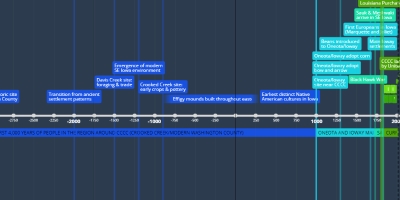SAUK AND MESKWAKI LIVING IN SOUTHEAST IOWA (jan 2, 1730 – jan 1, 1840)
Description:
This area was home to the Sauk and the Meskwaki for one century before Adam Ritchey settled along Crooked Creek and John Graham rode into town to buy up the land that would later become Camp. There were Sauk and Meskwaki communities all throughout the Mississippi River Valley in both northwestern Illinois and Southeast Iowa. As reported by Burrell and other historians, they were estimated to number about 7,000 in eastern Iowa before being removed from the state in the 1830’s and 40’s. There were two settlements particularly close to CCCC: a Sauk community of 400-500 people only 4½ miles west of this property, on the other side of Walnut Creek, and a Meskwaki community of about 300 less than 2 miles north of here. They lived in round houses with bark covering the outside, animal skins layering the inside, and a thatched roof of slough grass with a hole for smoke to escape through. They also had some larger longhouses, which were 10 to 12 feet wide and 40 to 60 feet long.During the winter and early spring they were away on hunting trips, trapping furbearers to trade to white settlers, or hunting herds of ko be tti ne no swa (buffalo) and me de we wa (elk) in the plains and prairies of western Iowa, up to hundreds of miles away. At permanent settlements like those along Crooked Creek and Walnut Creek, members of Sauk and Meskwaki families hunted deer and other local game. They also harvested useful materials like the inner bark of a linden trees for string, wild ginger for medicine to counteract food poisoning, and wild plums for plumbutter. As with most communities of Sauk and Meskwaki, the settlement on Crooked Creek was surrounded by cultivated fields. The villagers’ main crops were a ta mi, me sko tti sa, and wa bi ko ni, or as most of us know them: corn, beans, and squash. Farming was very central to the lifestyle and culture of both the Sauk and the Meskwaki, as illustrated by the ceremonial feasts and dances they held after harvest time each year.
It does not appear that the Sauk and Meskwaki ever chose to build their bark houses on the land where CCCC is now, and based on what early settlers remembered, the cultivated fields surrounding the Meskwaki village up the creek from Camp reached southward a few hundred yards short of here. Still, these 300 acres were part of their home. Chief Wapello took great pleasure in hunting along the creeks and rivers of this whole area for sport, and Meskwaki families sent their fathers and sons into the surrounding timber all throughout the summer to bring home meat for them. The Camp property is not much further from Chief Wapello’s house than the village he governed was, and the 1½ miles between here and the Meskwaki village—or the 4 miles between here and the Sauk village—are nothing in comparison to the tens or hundreds of miles they would travel to track down buffalo and elk on even a short hunting trip. People from Wapello and Powesheik’s communities caught fish and collected cattails from the same creek that campers tube down today. There are many native plants and animals on Camp property that have existed in this area for hundreds of years: along the paths of Crooked Creek Christian Camp we get to enjoy the great oak trees, the mayapple plants, the blackberry shrubs and the deer that eat from them. It is almost beyond doubt that these same things were once harvested from this forest by Meskwaki people coming down from Hardfish and Powesheik’s creek-side village, who referred to them instead as mismishi, mishi kite’imishi, ominaki, and be di ke si a.
Added to timeline:
Date:
jan 2, 1730
jan 1, 1840
~ 110 years
